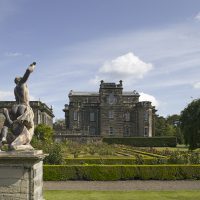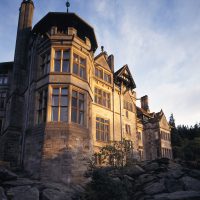
Despite being a remote county with few urban areas, Northumberland has been called home by an astounding number of notable figures throughout the centuries and the stately homes of the great and good can be found all around the county – many of which are open to the public. With the once hostile Scotland lying just over the border, the Lords of the Northern Marches were counted amongst the most powerful and influential in all the country.
In later, more peaceful, years their descendants built grand homes such as Howick Hall, seat of the once Prime Minister Earl Grey, Wallington Hall, the home of the Trevelyan family and the fabulously baroque Seaton Delaval Hall, built for Admiral Delaval. Alongside such magnificent statements of power, many of these houses also featured lavish gardens and parks. Of these, it is impossible to ignore one Kirkharle Hall. A quiet, unassuming little hall, Kirkharle and the nearby village owe their place in history to being the place where possibly the most famous English gardener of all time was born and it was at Kirkharle Hall where started his career – one Lancelot ‘Capability’ Brown.
 Of course, it’s not just the gentry who built such awe-inspiring Halls. Alongside the vast seams of County Durham, much of the coal used to power the burgeoning Industrial Revolution was mined from Northumbrian pits such as those at Ashington, Bedlington or around Newcastle-upon-Tyne and ships built upon the Tyne carried goods all around the growing British Empire. As such, Northumberland quickly became home to a great many wealthy Industrialists who had made their money from the coal-pits and shipyards of the North and were eager to demonstrate their wealth in the form of spectacular buildings and extensive grounds.
Of course, it’s not just the gentry who built such awe-inspiring Halls. Alongside the vast seams of County Durham, much of the coal used to power the burgeoning Industrial Revolution was mined from Northumbrian pits such as those at Ashington, Bedlington or around Newcastle-upon-Tyne and ships built upon the Tyne carried goods all around the growing British Empire. As such, Northumberland quickly became home to a great many wealthy Industrialists who had made their money from the coal-pits and shipyards of the North and were eager to demonstrate their wealth in the form of spectacular buildings and extensive grounds.
Out of these, perhaps the most famous is Lord Armstrong – at the time he was arguably one of the country’s most pre-eminent scientists, inventors and philanthropists. The son of a quayside
corn merchant who had worked his way up through Newcastle’s society, Armstrong initially pursued a career as a solicitor at his father’s behest. However, he had always maintained an interest in engineering and in time he moved onto starting his own company produced hydraulic cranes and later branched out into bridge building. However, it would be his advances in Artillery and Warships which would make Armstrong into a household name.

In addition to being considered the inventor of modern artillery, at one point the Armstrong shipyards at Elswick were the only yards in the world that could not only build a battleship, but also completely arm it. With this wealth, Armstrong began work on Cragside Hall at Rothbury, an extraordinary house that was not only the first house in the world to be lit be incandescent bulbs (Themselves invented just down the road at Gateshead), but also the first to be powered entirely by Hydro-Electricity. Truly a wonder-house, no endorsement of Northumberland’s stately homes would be complete without making mention of the marvel that is Cragside.











